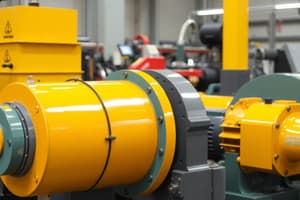Podcast
Questions and Answers
What is a key maintenance task for DC machines to prevent wear and tear and reduce vibration?
What is a key maintenance task for DC machines to prevent wear and tear and reduce vibration?
- Inspecting rotator bearings, commutator, and rotator windings
- Regular greasing and replacement of brushes (correct)
- Inspecting stator windings, insulation, and laminations
- Inspecting and cleaning slip rings
Which characteristic makes DC machines suitable for applications requiring high torque at low speeds?
Which characteristic makes DC machines suitable for applications requiring high torque at low speeds?
- Constant speed
- Lack of self-starting
- Efficiency
- High starting torque (correct)
What is a method used for speed control of DC machines by adjusting the resistance in the motor's circuit?
What is a method used for speed control of DC machines by adjusting the resistance in the motor's circuit?
- Varying the supply voltage
- Adjusting the motor's speed using gears (correct)
- Chopper or commutator-controlled method
- Applying lubrication to the bearings
Why do DC motors require external means like a starter or an external DC supply to start?
Why do DC motors require external means like a starter or an external DC supply to start?
Which component should be inspected and cleaned to prevent carbon buildup in DC machines?
Which component should be inspected and cleaned to prevent carbon buildup in DC machines?
What characteristic allows DC machines to maintain a constant speed as long as the voltage and load remain constant?
What characteristic allows DC machines to maintain a constant speed as long as the voltage and load remain constant?
What is the key difference between DC motors and generators?
What is the key difference between DC motors and generators?
In DC motors, how is torque and rotation produced?
In DC motors, how is torque and rotation produced?
Which of the following is NOT an application of DC machines?
Which of the following is NOT an application of DC machines?
How does an electric current generate in DC generators?
How does an electric current generate in DC generators?
What is the main function of DC motors in industrial processes?
What is the main function of DC motors in industrial processes?
How do DC machines operate in home appliances?
How do DC machines operate in home appliances?
Flashcards are hidden until you start studying
Study Notes
DC Machines
Direct Current (DC) machines have been shaping the electrical landscape for over a century, powering various industrial and consumer applications. Let's delve into the essential aspects of these machines, including their types, working principles, applications, maintenance, and characteristics.
Types of DC Machines
DC machines are classified into two main categories: motors and generators. The key difference lies in their rotational direction—motors convert electrical energy into mechanical work, while generators convert mechanical energy into electrical power.
Working Principle
The working principle of DC machines revolves around the interaction between a magnetic field and an electric current. In motors, an applied voltage to the armature creates a current, which generates a magnetic field that interacts with the stator's magnetic field to produce torque and rotation. In generators, the mechanical motion of the rotator generates an electric current through the rotating armature coils, which interact with the stationary stator field to produce electrical power.
Applications
DC machines have various applications, including:
- Traction – DC motors propel electric trains, streetcars, and subway systems.
- Industrial processes – DC motors power various industrial processes such as pumps, fans, and compressors.
- Home appliances – DC motors operate small appliances like vacuum cleaners, mixers, and clock gears.
- Military and aerospace – DC generators and motors power auxiliary systems in aircraft, ships, and military vehicles.
Maintenance
Proper maintenance is essential to ensure the longevity and efficiency of DC machines. Regular checks and inspection of the following components are required:
- Bearings – Regular greasing and replacement of bearings prevent wear and tear and reduce vibration.
- Brushes – Replace worn brushes to prevent arcing, which could lead to commutator damage and short-circuits.
- Slip rings – Inspect and clean slip rings to prevent carbon buildup, which could result in poor contact and short circuits.
- Rotator – Inspect rotator bearings, commutator, and rotator windings for wear, damage, or loose connections.
- Stator – Inspect stator windings, insulation, and laminations for signs of damage, wear, or short circuits.
Characteristics
DC machines have several inherent characteristics:
- Constant speed – DC machines maintain a constant speed as long as the voltage and load remain constant.
- High starting torque – DC machines have a high starting torque, which makes them suitable for applications requiring high torque at low speeds, such as traction and some industrial processes.
- Efficiency – DC machines tend to be less efficient than AC machines; however, advances in technology have improved their efficiency over the years.
- Lack of self-starting – DC motors require external means, like a starter or an external DC supply, to start the motor.
Speed Control
DC machines are well-suited for speed control, which can be achieved through various methods:
- Variable resistances – Adjusting the resistance in the motor's circuit can control the motor speed.
- Chopper or commutator-controlled – These methods involve controlling the voltage or current supplied to the motor to vary its speed, often referred to as DC drive systems.
- Varying the supply voltage – By adjusting the voltage input to the motor, its speed can be controlled. However, this method may not allow for precise speed control as the changes in voltage affect the torque.
The applications of DC machines are diverse, and their use continues to expand into fields such as renewable energy, transportation, and automation. Understanding their types, working principles, maintenance, characteristics, and speed control is essential for anyone interested in the development and implementation of DC machines in modern technology.
Studying That Suits You
Use AI to generate personalized quizzes and flashcards to suit your learning preferences.




